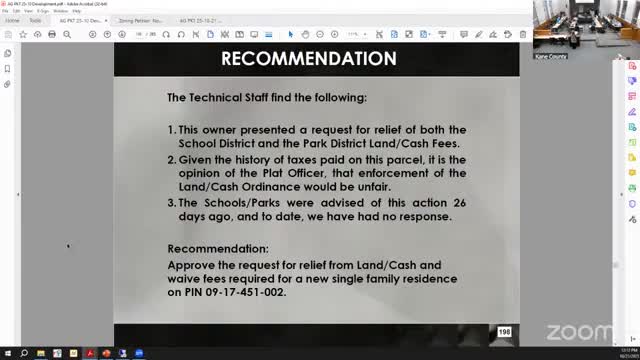Kane County staff seek more precise standards for solar‑farm screening after mixed results on recent sites
October 21, 2025 | Kane County, Illinois
This article was created by AI summarizing key points discussed. AI makes mistakes, so for full details and context, please refer to the video of the full meeting. Please report any errors so we can fix them. Report an error »

Kane County planning staff told the Development Committee they are seeking clearer standards for vegetative screening required around commercial solar energy facilities after multiple petitions with varying landscaping plans and outcomes.
Mark Van Kirkoff, director of development and community services, summarized an October staff review that compared other counties’ approaches and the county’s current standard, which requires a vegetative screen “for any part of the commercial solar energy facility that is visible to nonparticipating residents” and located between fencing and the property line. Van Kirkoff said the current rule is vague on two points most frequently in dispute: what “visible” means (distance, adjacent vs. nonadjacent properties, municipal views) and what constitutes a “continuous line.”
Staff described common stipulations used at recent approvals — minimum planting height at installation, maximum spacing on center, wildlife gaps, and a maintenance schedule — and noted several practical issues: some sites were fenced and operating before landscaping was installed; some plantings failed because of inadequate soil preparation or watering; and some neighbors preferred no evergreen screening because they did not want a “wall” in a farm landscape.
Commissioners sought more specificity. Commissioner Linder said arborvitae spaced 15 feet on center often leave large visual gaps and suggested closer spacing for certain species; Commissioner Ross noted species choice affects spacing and survivability and urged species lists with local suitability guidance. Several members recommended working with local conservation and forest-preserve staff to identify species and planting protocols appropriate for Kane County soils and climate. One commissioner proposed giving developers credit if they installed berms or other nonvegetative screening, even though county code cannot require berms outright.
Staff recommended three possible paths: continue approving site-by-site landscaping plans and stipulations, author a zoning-officer interpretation to provide guidance, or pursue a formal text amendment that would set minimum planting heights, spacing, species lists, installation timing and inspection/maintenance expectations. Van Kirkoff raised the administrative cost of inspections and noted that enforcement would rely on the county’s existing adjudication process for noncompliance.
Commissioners asked staff to consult with local conservation partners and draft a proposed standard that specifies species, spacing (by species), minimum initial planting height, replacement timing for failed plantings, and a timeline for installation tied to construction milestones. The committee did not adopt new standards at this meeting; staff will return with recommended language for committee consideration.
Mark Van Kirkoff, director of development and community services, summarized an October staff review that compared other counties’ approaches and the county’s current standard, which requires a vegetative screen “for any part of the commercial solar energy facility that is visible to nonparticipating residents” and located between fencing and the property line. Van Kirkoff said the current rule is vague on two points most frequently in dispute: what “visible” means (distance, adjacent vs. nonadjacent properties, municipal views) and what constitutes a “continuous line.”
Staff described common stipulations used at recent approvals — minimum planting height at installation, maximum spacing on center, wildlife gaps, and a maintenance schedule — and noted several practical issues: some sites were fenced and operating before landscaping was installed; some plantings failed because of inadequate soil preparation or watering; and some neighbors preferred no evergreen screening because they did not want a “wall” in a farm landscape.
Commissioners sought more specificity. Commissioner Linder said arborvitae spaced 15 feet on center often leave large visual gaps and suggested closer spacing for certain species; Commissioner Ross noted species choice affects spacing and survivability and urged species lists with local suitability guidance. Several members recommended working with local conservation and forest-preserve staff to identify species and planting protocols appropriate for Kane County soils and climate. One commissioner proposed giving developers credit if they installed berms or other nonvegetative screening, even though county code cannot require berms outright.
Staff recommended three possible paths: continue approving site-by-site landscaping plans and stipulations, author a zoning-officer interpretation to provide guidance, or pursue a formal text amendment that would set minimum planting heights, spacing, species lists, installation timing and inspection/maintenance expectations. Van Kirkoff raised the administrative cost of inspections and noted that enforcement would rely on the county’s existing adjudication process for noncompliance.
Commissioners asked staff to consult with local conservation partners and draft a proposed standard that specifies species, spacing (by species), minimum initial planting height, replacement timing for failed plantings, and a timeline for installation tied to construction milestones. The committee did not adopt new standards at this meeting; staff will return with recommended language for committee consideration.
Don't Miss a Word: See the Full Meeting!
Go beyond summaries. Unlock every video, transcript, and key insight with a Founder Membership.
✓
Get instant access to full meeting videos
✓
Search and clip any phrase from complete transcripts
✓
Receive AI-powered summaries & custom alerts
✓
Enjoy lifetime, unrestricted access to government data
30-day money-back guarantee

